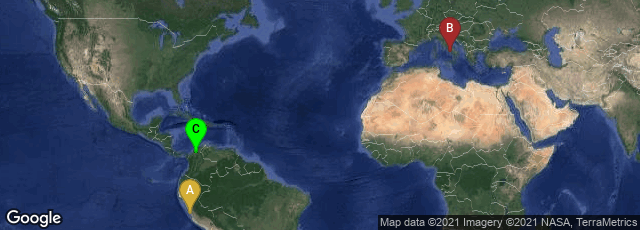
A: Rímac, Municipalidad Metropolitana de Lima, Peru, B: Napoli, Campania, Italy, C: Sucre, Colombia
The first extensive treatise on the Peruvian knot-based counting language, the Quipu was Lettera apologetica dell'esercitato accademico della Crusca contenente la Difesa del Libro Intitolato Lettere d'una Peruana per rispetto alla supposizione de'Quipu published in 1750 by the Neopolitan polymath and inventor Raimondo di Sangro, Prince of Sansevero, from the press of Gennaro Morelli of Naples. This work, printed in color using a polychromatic printing process invented by the Prince, was the first extensive treatise on the Peruvian knot-based counting language, the Quipu.
Quipu used a decimal positional system: a knot in a row farthest from the main strand represented one, next farthest ten, etc.; the absence of knots on a cord implied zero. The colors of the cords, the way the cords are connected together, the relative placement of the cords, the spaces between the cords, the types of knots on the individual cords, and the relative placement of the knots are all important parts of the recording system. ‘Quipucamayocs,’ the accountants of the Inca Empire, created and deciphered the Quipu knots, and were also capable of performing simple mathematical calculations such as adding, subtracting, multiplying, and dividing. Quipu accounts were kept by court historians in Peru that covered hundreds of years of history, but after the Conquest, the Spaniards began to resent having this second set of record-keepers contradict them. The Quipu was classified as idolatrous at the Third Council of Lima (1581-3), many examples were destroyed. Thus, by the time Raimondo di Sangro published his book the Quipu was no longer practiced, and attempting to understand the language was a research project in cryptanalysis.
"To date, no link has yet been found between a quipu and Quechua, the native language of the Peruvian Andes. This suggests that quipus are not a glottographic writing system and have no phonetic referent. Frank Salomon at the University of Wisconsin has argued that quipus are actually a semasiographic language, a system of representative symbols—such as music notation or numerals—that relay information but are not directly related to the speech sounds of a particular language. The Khipu Database Project (KDP), begun by Gary Urton, may have already decoded the first word from a quipu—the name of a village, Puruchuco, which Urton believes was represented by a three-number sequence, similar to a ZIP code. If this conjecture is correct, quipus are the only known example of a complex language recorded in a 3-D system. (Wikipedia article on Quipu, accessed 04-07-2013).